The AMD Ryzen Threadripper 1950X and 1920X Review: CPUs on Steroids
by Ian Cutress on August 10, 2017 9:00 AM ESTCPU Legacy Tests
Our legacy tests represent benchmarks that were once at the height of their time. Some of these are industry standard synthetics, and we have data going back over 10 years. All of the data here has been rerun on Windows 10, and we plan to go back several generations of components to see how performance has evolved.
All of our benchmark results can also be found in our benchmark engine, Bench.
3D Particle Movement v1
3DPM is a self-penned benchmark, taking basic 3D movement algorithms used in Brownian Motion simulations and testing them for speed. High floating point performance, MHz and IPC wins in the single thread version, whereas the multithread version has to handle the threads and loves more cores. This is the original version, written in the style of a typical non-computer science student coding up an algorithm for their theoretical problem, and comes without any non-obvious optimizations not already performed by the compiler, such as false sharing.
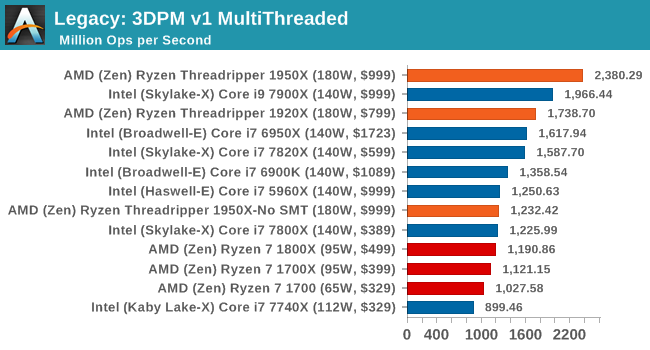
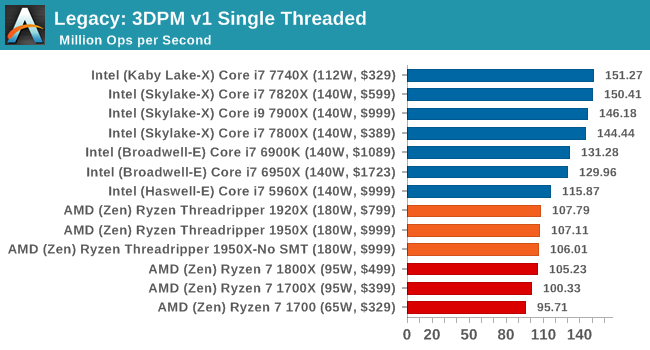
CineBench 11.5 and 10
Cinebench is a widely known benchmarking tool for measuring performance relative to MAXON's animation software Cinema 4D. Cinebench has been optimized over a decade and focuses on purely CPU horsepower, meaning if there is a discrepancy in pure throughput characteristics, Cinebench is likely to show that discrepancy. Arguably other software doesn't make use of all the tools available, so the real world relevance might purely be academic, but given our large database of data for Cinebench it seems difficult to ignore a small five minute test. We run the modern version 15 in this test, as well as the older 11.5 and 10 due to our back data.
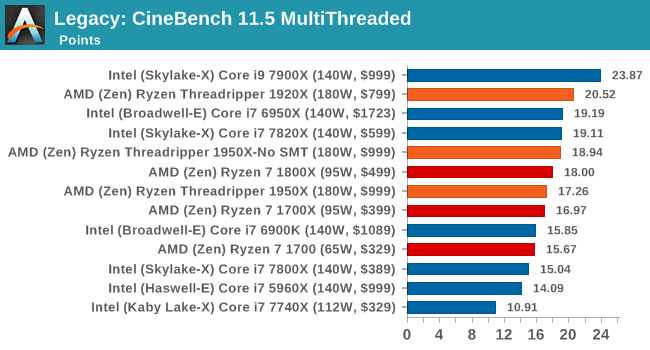
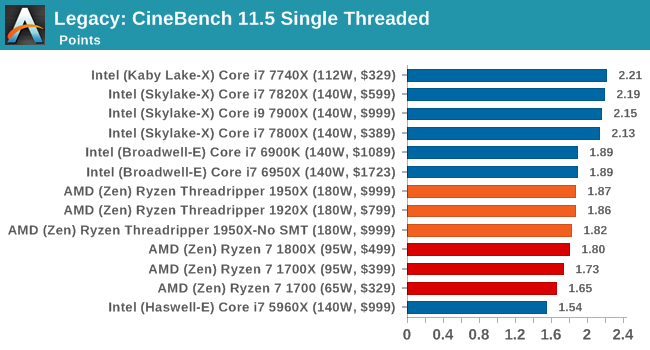
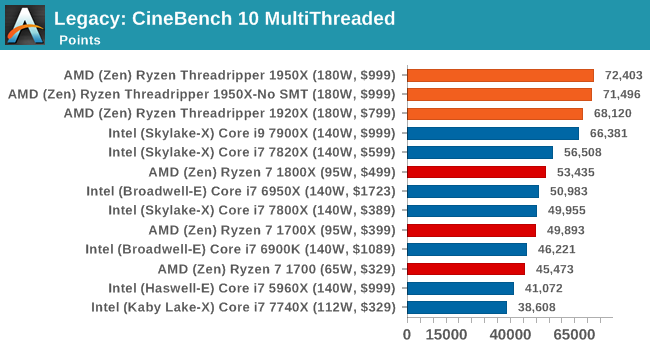
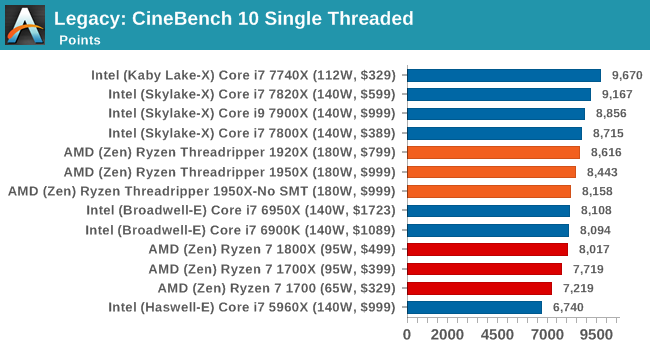
x264 HD 3.0
Similarly, the x264 HD 3.0 package we use here is also kept for historic regressional data. The latest version is 5.0.1, and encodes a 1080p video clip into a high-quality x264 file. Version 3.0 only performs the same test on a 720p file, and in most circumstances the software performance hits its limit on high-end processors, but still works well for mainstream and low-end. Also, this version only takes a few minutes, whereas the latest can take over 90 minutes to run.
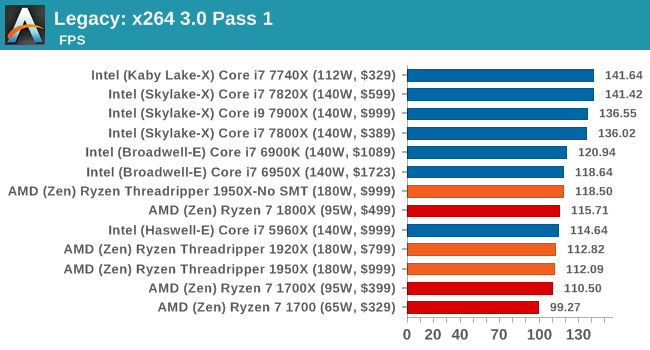
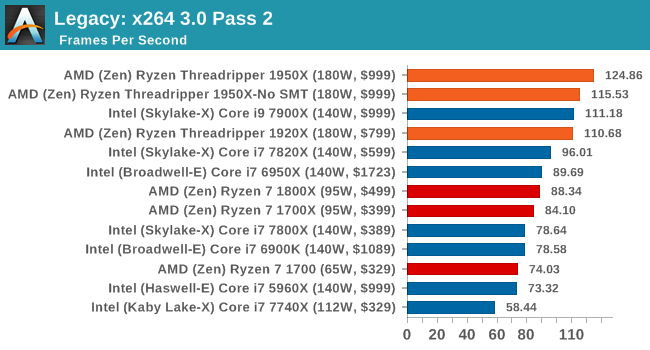
The 1950X: the first CPU to score higher on the 2nd pass of this test than it does on the first pass.










347 Comments
View All Comments
mapesdhs - Friday, August 11, 2017 - link
I haven't checked, is the TDP of a 32c EPYC a lot higher, with consequently higher clocks?JedTheKrampus - Thursday, August 10, 2017 - link
Here are a few potential benchmark ideas that I'd like to see.- Zbrush. (High resolution dynamesh/projection, Zremesher, or Decimation Master.)
- Unreal Engine 4. (Lightmap baking on a sample map, perhaps one from Unreal Tournament 4. Perhaps compilation of the engine itself.)
- XNormal. (Ambient occlusion texture baking.)
- Some sort of database benchmark for the poor sods who are doing web development.
- Some sort of video editor benchmark.
T1beriu - Thursday, August 10, 2017 - link
Luxmark OpenCL: "Though it's interesting just how cost the 10-thread Core i9-7900X gets here, likely due to a combination of higher IPC and clockspeeds."1. Typo?
2. 7900X it's not in the chart.
Ian Cutress - Thursday, August 10, 2017 - link
When we initially ran the 7900X and other CPUs, Luxmark was failing for no obvious reason. We narrowed down the reason a few weeks ago - it doesn't like running when a GTX 950 is installed for detection reasons. We have since moved to RX 460s being used during our CPU benchmark runs.gzunk - Thursday, August 10, 2017 - link
The only thing I might take exception at is the notion that prosumers have never seen NUMA before, since both the Z9-PE and Z10-PE offer it. I myself had the Z9-PE with a pair of Sandy Bridge Xeons.mapesdhs - Thursday, August 10, 2017 - link
I've lost count of how often I've read the specs pages for those mbds, etc. Talked to so many prosumers who ideally would buy one of those boards, but the XEON costs were prohibitive.SpartanJet - Thursday, August 10, 2017 - link
Well that was disappointing. Guess I'm waiting for Coffee Lake for my new gaming rig.Total Meltdowner - Thursday, August 10, 2017 - link
Yea, I'm not regretting my 1800x right now. Too bad. I had high hopes for threadripper.Let's see how drivers and BIOS updates help it, assuming they will.
Johan Steyn - Thursday, August 10, 2017 - link
Yes, you are right, TR is not the best gaming rig. Maybe this article misses again to even try to compare TR as a gaming machine. It is good to point out that Intel will be better, even though not compared to price. But this article made me think TR is made to be a gaming CPU. Ryzen is meant for that. When games support 32 threads, that will change, but not soon. This is a workstation class machine. It is almost like buying a Xeon to run games with.PS, I would not buy CL though.
mapesdhs - Thursday, August 10, 2017 - link
I hope AMD tailors its PR to make this clear. Focusing any hype on gaming where it's obviously not warranted could miss a lot of potential very suitable buyers.What does bug me though is the absence of reviewers mentioning that while Intel's 4-core CPUs do well for gaming right now, isolated to just that task, they have nothing in reserve to handle what are rapidly growing areas such as live streaming of games. GN showed a huge difference in viewer experience for game streaming between a 1700 and a 7700K.